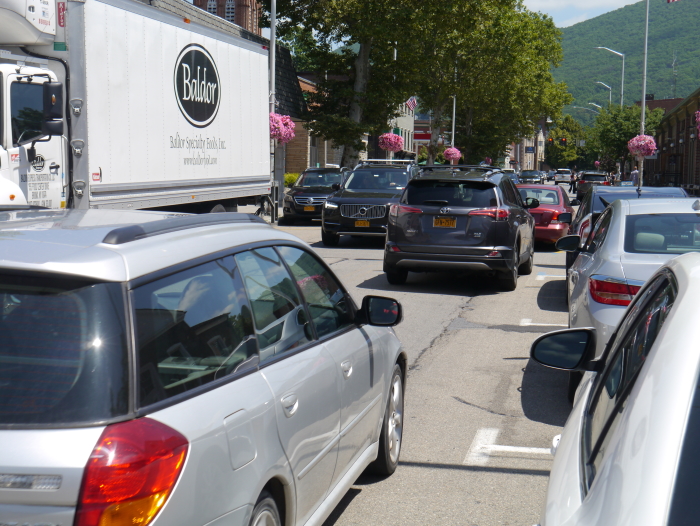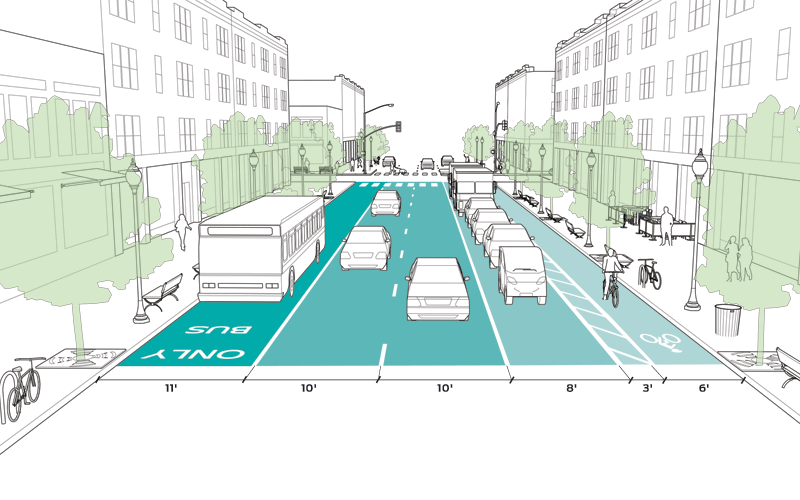Beacon council to address parking, congestion on Main
By Jeff Simms
With success often come challenges and, in Beacon, that may be evident on Main Street more than anywhere else.
It’s on Main — the city’s mile-long major artery — that business is thriving, for the most part, although some shops have closed in recent months and the owners of some that remain open say rents are becoming unsustainable.
But on most weekends, and increasingly during the week, customer traffic is up considerably from a few years ago. That, too, has led to challenges.
Parking can be scarce and, with cars on both sides of the street, there’s not a lot of room — 32 to 34 feet — for two lanes of traffic, bikers, pedestrians, city buses and delivery trucks.
The City Council has Main Street on its agenda for a July 29 workshop and Council Member Jodi McCredo has proposed some fairly radical changes to address congestion. She’s asked the council to discuss removing parking from one side of Main to widen the driving lanes and add a dedicated bike lane. Alternatively, Main Street could become one-way.

The state Department of Transportation recommends 5-foot-wide bike lanes on streets with parking, but in places like Beacon where the road is narrow, “shared-lane markings” are required to indicate that bikers and motorists should travel in the same lane, rather than side by side.
“Main Street is just too narrow,” McCredo said in an interview. “If a bus or a truck is driving [in one direction] and the cars aren’t parked right against the curb on the other side, you can’t get past them. I’ve heard so many stories of people getting their side mirrors taken off that they don’t park on Main Street anymore.
“As a parent, I’m terrified to have my kids riding their bikes down Main,” she added. “It’s not working for the drivers or the bikers. It’s not working for anyone.”
While wider lanes might solve some problems, Mayor Randy Casale said he believes they would just create others.
“People will go faster down Main Street because it’s not as narrow,” he predicted, “so it becomes a speeding problem.” And if parking is removed from one side of the street, “where are all those people going to go to park?” he asked.
Casale said he’d rather see designated hours for delivery trucks to stop on Main and enforcement of a 12-inch-from-the-curb parking regulation as well as a campaign encouraging people to park elsewhere.
By comparison, Main Street in Cold Spring is 38 to 40 feet wide, Highway Crew Chief Robert Downey said, with parking spaces 8 to 10 feet wide. Beacon’s spaces on Main are about 8 feet wide. “Older towns have narrower streets because they were built for smaller cars,” Downey explained.
(In its Urban Street Design Guide, the National Association of City Transportation Officials recommends driving lanes be 10 feet wide and parking lanes be 7 to 9 feet and notes that “narrower streets help promote slower driving speeds which, in turn, reduces the severity of crashes.”)

During a public hearing on a proposed building moratorium during the City Council’s July 15 meeting, resident Elaine Ciaccio urged the council to do something about Main Street because “it’s becoming unpassable.” She also described driving on Main when a city bus approached in the opposite direction.
“With the way people park, I’m lucky I didn’t lose half my car,” she said. “Then you come around the bend by Howland [Avenue] and if somebody’s getting a delivery, you have to drive blind around the truck that’s double-parked on the corner.”
McCredo said that since much of the evidence for congestion is anecdotal — the county’s most recent traffic data for the street, from 2015, was virtually unchanged from 2014, and Beacon Police report 64 accidents on Main so far this year compared to 75 during the same period in 2018 — she hopes residents will attend council meetings and provide feedback on her ideas.
“If there’s support, I’m willing to fight for it,” she said.

This is a fantastic idea that should have happened long ago. It is patently absurd that so much public space is given away to private storage. Biking on Main is a dangerous game and dedicated space would be a godsend!
I also feel that Mr. Downey has the facts wrong when he says “older towns have narrower streets because they were built for smaller cars.” Older towns were not build with cars in mind at all, most of Beacon was designed and built before cars were invented. Beacon streets were designed for pedestrians and trolleys. The streets were never designed to be used for private storage; they were designed to be used by the people.
This idea comes up every couple of years. It would look pretty and certainly make the street safer, but it would be a disaster for the businesses that rely on people finding parking and for residents and others trying to find parking along or near Main Street.
If Beacon officials are going to remove parking from one side of Main, they had better build two parking garages to pick up the slack. They also better speak with the people who live on the side streets, which will become parking streets. It will also require an overhaul of the zoning laws concerning parking requirements for Main Street buildings.
The mayor has it right. Limit delivery trucks to specific times, enforce the parking rules, especially around the bend and near Rite-Aid, and potentially make the buses use the cross streets instead of going up and down Main.
It’s not entirely true that most of Beacon was designed and built before cars were invented. Central Main Street was developed much later than the east end (Matteawan) or the west end (Fishkill Landing). Almost all of the west end is gone, torn down for urban renewal in the 1960s and 1970s. Most of the central buildings are from the 1930s through the 1960s, with a few exceptions.
I’ve lived in Beacon for 35 years, and Main Street has always been too narrow for two-way traffic. You always have to be aware of people opening doors and other cars stopping to park. It’s a slow go. Any changes that are made, such as bike lanes, will just bring up other issues that need to be addressed.
Most of the congestion is on the weekends due to tourists. What could we do to encourage more visitors to park at the station, take the Beacon Free Loop (or trolley on Sundays) and walk on Saturday and Sunday? Throwing that out there. It’s an option. Plenty of parking at the station.
Even though Main Street in Cold Spring is wider than its counterpart in Beacon, some of the same issues are still encountered. When multiple delivery trucks are in the area, it is difficult getting up or down. Visibility from the side streets is horrendous. You have to carefully nose yourself out.
Visibility is also an issue with pedestrian crosswalks. Because of cars being parked too close to the crosswalk both the pedestrians and the drivers have difficulty seeing each other.
Bikes should not be on Main Street. Getting down Main is no big deal on weekdays. I drive in Manhattan every couple of weeks. That’s a zoo!
Yeah, great — remove spaces so people will have to drive around aimlessly looking for the few that are left. Then there will be more people pulling U-turns on Main, further tying up traffic. Pretty soon we will have a five-story parking garage. Welcome, urban blight!
No way to one-way on Main Street. Verplanck Avenue would get way too much traffic. A bike lane and one-side parking sounds like a better idea.
Although the area around the road now known as Main Street in Beacon was initially built before automobiles existed, that portion within a block or two of Chestnut was encroached upon by property owners apparently sometime after World War Two. One merely needs to look at the additions changing the building setbacks on the south side of the street compared to the rest of Main.
When this happened it cut into the available public right-of-way and has thereby reduced the width of the street and of the sidewalks.
The same process is in danger of occurring today. Property owners generally want to control and impede the right of way, for their own reasons, and to encroach upon public land, if they can get away with it.